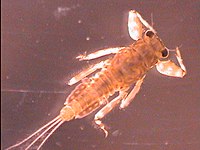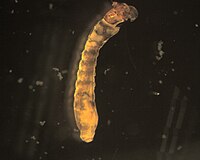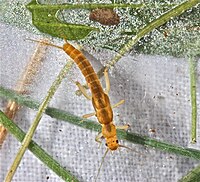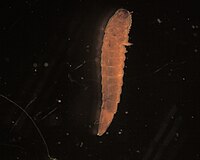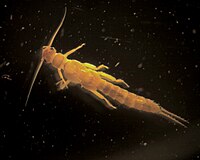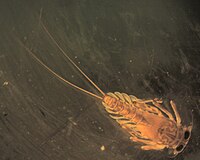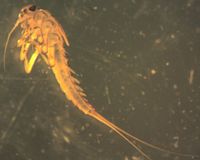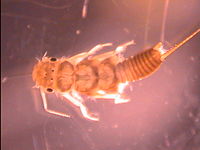Vermont EPSCoR's Streams Project; A Teacher Collaboration on WikiEducator
Openly shared content, practices, and developing resources from Vermont EPSCoR's Streams Project. Join this collaboration and make a difference!
 Mettawee River |
|---|
|
| Stream code: | LCC_MetRv_1506 |
| Basin: | Lake Champlain Canal |
| State or Province: | Vermont |
| Country: | USA |
| Latitude: | 43.28463333 |
| Longitude: | -73.04741667 |
| School: | Long Trail School |
The following are the most common invertebrates collected from this stream site.
Drunella
- Order
- Ephemeroptera
- Family
- Ephemerellidae
- Genus
- Drunella
- Tied fly
- Bluewinged Olive Dun
The mayfly Drunella is distinguished by its large femoral “biceps;” these femora have tubercles on the leading margins. Gills are present on segments 3-7.
Simuliidae
- Order
- Diptera
- Family
- Simuliidae
Simuliidae appear rather like bowling pins with heads. Relatively speaking, we collect few members of this family and have we have not identified them past family at this point.
Click here for a close up image of the heads.
Leuctra
- Order
- Plecoptera
- Family
- Leuctridae
- Genus
- Leuctra
This family of stonefly is fairly slender by stonefly standards. The divergent wing pads are a helpful characteristic. Leuctridae are similar in overall shape to the Capniidae; however, Leuctridae often do not have pleural folds. If they are present, they only extend from abdominal segments 1-7.
Leuctra are recognized by abdominal terga with posterior fringes of short hairs and last few segments with longer hairs.
Image of the divergent wing pads.
Optioservus
- Order
- Coleoptera
- Family
- Elmidae
- Genus
- Optioservus
The larvae of
Optioservus have open coxae, as determined by the straight definition between segments on the ventral side of the pronotum.
The adult Optioservus have a compact appearance, especially the head and thorax. There are also dorsal ridges and a characteristic diamond-shaped sutellum observable in the dorsal view.
Images of the straight definition between segments, the dorsal ridgesand the diamond-shaped scutellum.
Chironomidae
- Order
- Diptera
- Family
- Chironomidae
- Common name
- Nonbiting midge
- Tied fly
- Griffith's Gnat
Midge larvae tend to be the most common macroinvertebrate at our sites. As with other Diptera, there are no true jointed legs. Chironomidae do have a pair of prolegs at each end and preserved individuals tend to curl into a 'C'. Identification past family requires slide-mounted heads. We have seen philopotamid caddisflies misidentified with the chironomids and we suspect that that happens when samples are being sorted from trays. Under a microscope, six prominent legs can be seen on members of the caddisfly family Philopotamidae.
More information on Philopotamidae.
Alloperla
- Order
- Plecoptera
- Family
- Chloroperlidae
- Genus
- Alloperla
Chloroperlids stoneflies are quite slender relative to most other stoneflies. The adults are green but this trait does not show up in the nymphs. Chloroperlids from this genus are characterized by a fringe of intrasegmental setae on their cerci.
Image of the intrasegmental setae.
Epeorus
- Order
- Ephemeroptera
- Family
- Heptageniidae
- Genus
- Epeorus
- Common name
- The Quill Gordon
- Tied fly
- Quill Gordon
This is the only Heptageniidae genus present in this area with two tails!
Baetis
- Order
- Ephemeroptera
- Family
- Baetidae
- Genus
- Baetis
- Common name
- The Little Olive
- Tied fly
- Sawyer Pheasant Tail Nymph
This mayfly has three "tails" and a unique head shape. Its gills are oval shaped and insert dorsally. More mature nymphs have long, dark wing pads.
Image of the long, dark wing pads.
Acroneuria
- Order
- Plecoptera
- Family
- Perlidae
- Genus
- Acroneuria
Acroneuria are among the most common Perlid stoneflies that we find. The larvae have a close-set postocular fringe consisting of thick spinules. They have three ocelli, and a yellow m-shaped mark in front of the middle ocellus. The bases of their cerci have thick, silky setae.
The postocular fringe can be seen here. Look in front of the three ocelli for the yellow m-shaped mark. Focus where the cerci meet the body to see the thick, silky setae.

